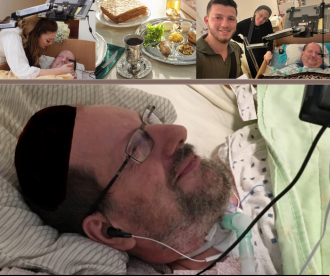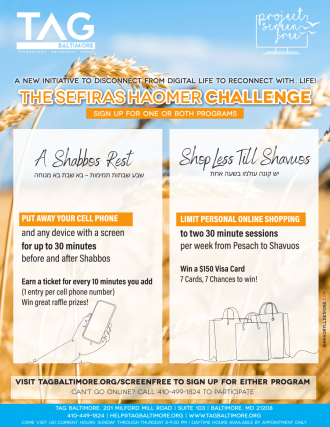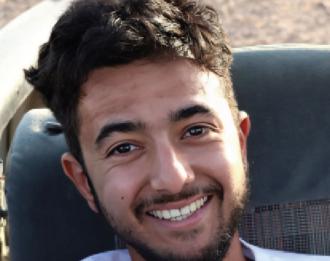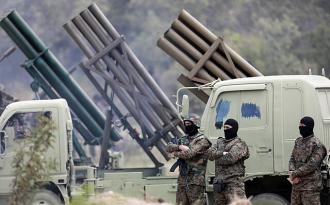He was a lonely older man without any living family. He came into the hospital with severe COVID but, after several days, stabilized. He wasn’t getting better and he wasn’t getting worse. We had given him all the standard treatments and were hopeful that he would improve. Then, as is often the case with COVID-19, he rapidly deteriorated over the course of a day and ended up on life support.
I went in to see him as I usually do with my PAPR on feeling like an astronaut on a space walk, minus the sense of weightlessness. The PAPR creates a soft wind noise and you have to shout to be heard through its cold plastic shield. This combines with the noise of the large negative pressure vacuum in the room to create the sensation of trying to have a conversation inside a vacuum cleaner. He was delirious and as much as the staff and I tried to care for and be with him, you can only connect with someone so much through the noise and PPE. He was alone in that room even when we were in there with him. I did my best to reorient and reassure him.
He died relatively suddenly. His oxygen rapidly declined and we couldn’t get it back up. His heart stopped suddenly but, when you think about it, whenever the heart stops it is sudden. We did CPR for about 20 minutes but there was no response.
He was the second COVID death in the ICU in a week that had seen a rise in admissions that mirrored a rise nationwide. There was also a dark feeling that hung over the unit like seeing gathering dark clouds on the horizon relentlessly approaching.
The fall/winter rise was predicted by most experts and it appears it is upon us. Here in Maryland the governor just tightened restrictions because of a rapid spike in hospitalizations. This is happening across the country and the world.
Amidst this harrowing darkness came the first streaks of hope. We are all awaiting the vaccine but there was a concern that it would not be fully effective. For example, if a vaccine is 50% effective and only 50% of the population takes it that would lead to only 25% of the population being protected. This would leave us a long way from herd immunity. So you can imagine the joy when the pharmaceutical giant Pfizer announced early this week that an interim analysis of their vaccine showed 90% effectiveness exceeding everyone’s expectations.
The fall/winter rise was predicted by most experts and it appears it is upon us.
Before we plan our post COVID parties, we need to understand what this report means. For several months, the researchers have given >40K subjects either the vaccine or placebo in two separate doses three weeks apart. They then followed them to see how many people got infected. So if there were 200 cases in the placebo group and none in the vaccine group the vaccine would be considered 100% effective. If it was 200 and 100 it would be 50% effective. The study was designed to analyze the data after they had 32, 94, and 164 infections. In this second analysis they arrived at the 90% number. (As an aside, you can see how these studies can happen so fast. If there are a lot of infections in the general population they will arrive at these case number milestones more quickly.)
90% is an unbelievably positive result but it needs to be accepted with cautious optimism as there are caveats. The biggest is that the case rate was relatively low. The trial will continue until a total of 164 COVID-19 cases are detected, so initial estimates of the vaccine’s effectiveness could decrease. With that said, it is highly unlikely that the effectiveness will drop below the 50% threshold for FDA approval.
Additionally, this was from a press release by Pfizer of a preliminary analysis of the data which has yet to be peer reviewed. The full data should be analyzed soon.
There are other issues that we will need to wait to find the answers to. First, it is not clear yet if the vaccine prevents severe disease or if it prevents transmission. The 90% refers to preventing symptomatic disease such as fever and cough but not symptoms that are severe enough to lad to hospitalization or death. This may come with the final data analysis or may require post approval analysis. Second, it not known how long immunity from a vaccine will last. Finally, the vaccine requires 2 doses and extreme cold storage which may create logistical barriers.
There is other good news about this vaccine. It did not get any government support or direction in its development (although the US government did purchase 100 million doses in advance). This means that any accusations of political interference would be ridiculous, although we do seem to live in a time where people passionately believe ridiculous accusations. Additionally, unlike other vaccine trials, there were no pauses to analyze safety events.
This means that by April it is possible for everyone who wants to be vaccinated to get their shot.
Let’s put the caveats aside and discuss the expected timeline if these resuls hold up in the final analysis:
- Pfizer has said that it would seek an emergency use authorization from the FDA around the third week of November, at which point half of the participants will have been followed for two months — an FDA safety requirement for COVID-19 vaccines. The FDA then will evaluate the data and likely approve the vaccine by early December.
- The manufacturing has already been set up months in advance so the vaccine is ready to come off the assembly line as soon as its approved. This means the first wave could get vaccinated in December or January. This likely will include frontline healthcare workers such as yours truly and high risk patients such as those in nursing homes. Just in case you’re wondering, I will be getting my vaccine as soon as someone offers it to me – I’m not the least bit nervous. I may camp out to get to the front of the line.
- The vaccine will continue to roll out over the ensuing months and there are predictions that most Americans who want can be vaccinated by the end of April. This may be too optimistic as a lot of people need to be vaccinated but other vaccines are expected to come available soon as well expanding the number of people that can be covered in some way.
Let that soak in for a moment. This means that by spring or early summer it is possible for everyone who wants to be vaccinated to get their shot (pun intended). At that point the pandemic will be mostly over. Every time I think of that a wave of joy comes over me.
OK, now back to reality. We now have to deal with two equal and opposite realities. We are currently entering a very dark winter where things are likely to get quite difficult. My hospital has seen a dramatic spike in COVID admissions and is currently full. We will struggle mightily if we get a rush of new COVID patients. We’re all on edge. Many worry that the country might look like New York in the spring only worse – instead of just one region being affected the whole country will be affected. As of now our only hope is for you and everyone to push through the pandemic fatigue and keep distancing, wearing masks, and staying home when sick (even if you’re “sure” it’s not COVID). The more we stay together in fighting this pandemic the less painful it will be for all of us so stay strong until we get the all clear from the people who know (not just social media “experts).
Worry not, however, this dark tunnel has a light at the end that just got a bit brighter. If the vaccine data continues to be this positive we will start to see an end to this nightmare before you known it. We just need to hang on a bit more.










